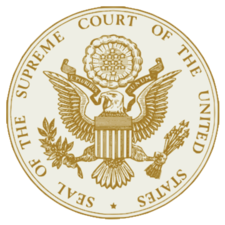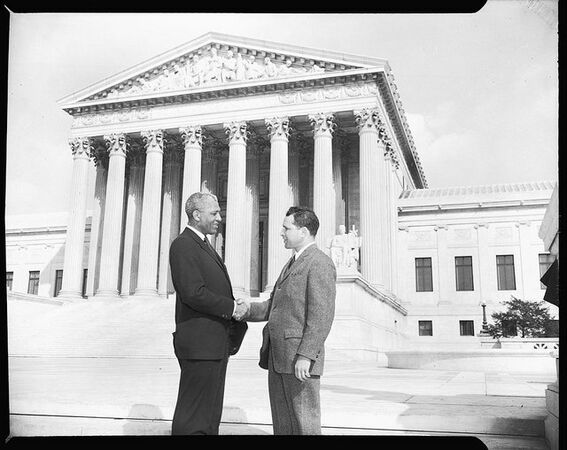Edwards v. Vannoy
 | |
| Edwards v. Vannoy | |
| Term: 2020 | |
| Important Dates | |
| Argument: November 30, 2020 Decided: May 17, 2021 | |
| Outcome | |
| Affirmed | |
| Vote | |
| 6-3 | |
| Majority | |
| Brett Kavanaugh • Chief Justice John G. Roberts • Clarence Thomas • Samuel Alito • Neil Gorsuch • Amy Coney Barrett | |
| Concurring | |
| Clarence Thomas • Neil Gorsuch | |
| Dissenting | |
| Elena Kagan • Stephen Breyer • Sonia Sotomayor | |
Edwards v. Vannoy is a case argued before the Supreme Court of the United States on November 30, 2020, during the court's October 2020-2021 term. The court affirmed the decision of the United States Court of Appeals for the 5th Circuit in a 6-3 ruling, holding that the jury-unanimity rule established by the Supreme Court in Ramos v. Louisiana does not apply retroactively on federal collateral review. Justice Brett Kavanaugh delivered the majority opinion of the court. Justice Elena Kagan filed a dissent, joined by Justices Stephen Breyer and Sonia Sotomayor.[1] Click here for more information about the ruling.
You can review the lower court's opinion here.
Timeline
The following timeline details key events in this case:
- May 17, 2021: The U.S. Supreme Court affirmed the decision of the United States Court of Appeals for the 5th Circuit, holding that the jury-unanimity rule established by the court in Ramos v. Louisiana does not apply retroactively on federal collateral review.[1]
- November 30, 2020: The U.S. Supreme Court heard oral argument.
- May 4, 2020: The court agreed to hear the case.
- August 15, 2019: Thedrick Edwards, the petitioner, filed a petition with the U.S. Supreme Court.
- May 20, 2019: The 5th Circuit denied Edwards' motion for a certificate of appealability.
- September 13, 2018: The U.S. district court dismissed Edwards' petition for a writ of habeas corpus.
Background
Thedrick Edwards, the petitioner, was convicted in the Louisiana 19th Judicial District Court of five counts of armed robbery, one count of attempted armed robbery, two counts of aggravated kidnapping, and one count of aggravated rape. A non-unanimous jury found Edwards guilty. He was sentenced to 30 years imprisonment on each armed robbery count and to life imprisonment on the aggravated kidnapping and aggravated rape counts. The sentences were issued without the possibility of probation, parole, or suspension.[2]
Edwards appealed his conviction and sentence, which the Louisiana 1st Circuit Court of Appeal and the Louisiana Supreme Court denied. Edwards sought and was subsequently denied post-conviction relief. He also sought and was denied review by the U.S. Supreme Court.[2]
Edwards filed a petition for habeas corpus with the U.S. District Court for the Middle District of Louisiana. The district court denied Edwards' claim. Edwards appealed to the U.S. Court of Appeals for the 5th Circuit, which refused to issue a certificate of appealability.[2]
Louisiana's non-unanimous jury rule
When Edwards submitted his petition to the U.S. Supreme Court, Louisiana Code of Criminal Procedure Article 782 allowed for a non-unanimous jury rule in which 10 of 12 jurors needed to concur in a criminal trial whose punishment required confinement and hard labor.
Ramos v. Louisiana
- See also: Ramos v. Louisiana
The U.S. Supreme Court decided Ramos v. Louisiana during its 2019 term. It came on a writ of certiorari to the Louisiana 4th Circuit Court of Appeal. The case asked whether the 14th Amendment fully incorporated the 6th Amendment guarantee of a unanimous verdict.
The 6th Amendment of the United States Constitution provides the accused in a criminal prosecution the right to an impartial jury trial. The 14th Amendment requires states to provide equal protection under the law.
In a 6-3 ruling, the U.S. Supreme Court held that the 6th Amendment's right to a unanimous jury verdict to support a conviction applied in state courts. The ruling overturned a 1972 SCOTUS case, Apodaca v. Oregon.
Questions presented
The petitioner presented the following questions to the court:
| Questions presented: Whether the U.S. Supreme Court’s decision in Ramos v. Louisiana (2020) applies retroactively to cases on federal collateral review.[3] In Ramos v. Louisiana, the U.S. Supreme Court held that the 6th Amendment's right to a unanimous jury verdict to support a conviction applies in both federal and state courts. Click here for more information. |
Outcome
In a 6-3 opinion, the court affirmed the decision of the United States Court of Appeals for the 5th Circuit, holding that the jury-unanimity rule established by the court in Ramos v. Louisiana does not apply retroactively on federal collateral review.[1] Justice Brett Kavanaugh delivered the opinion of the court. Justices Clarence Thomas and Neil Gorsuch filed concurring opinions and Justice Elena Kagan wrote a dissent.
Opinion
In his opinion, Justice Brett Kavanaugh wrote:[1]
| “ | Last Term in Ramos v. Louisiana, 590 U. S. ___ (2020), this Court held that a state jury must be unanimous to convict a criminal defendant of a serious offense. ...
In light of the Court’s well-settled retroactivity doctrine, we conclude that the Ramos jury-unanimity rule likewise does not apply retroactively on federal collateral review. We therefore affirm the judgment of the U. S. Court of Appeals for the Fifth Circuit. [4] |
” |
| —Justice Brett Kavanaugh | ||
Concurring opinion
Justice Clarence Thomas
Justice Clarence Thomas filed a concurring opinion, joined by Justice Neil Gorsuch.[1]
In his concurring opinion, Justice Thomas wrote:
| “ | I join the majority in full because it correctly charts its way through precedent to hold expressly what we have long
implied: “New procedural rules do not apply retroactively on federal collateral review.” Ante, at 15. I write separately to highlight that we could also have resolved this case by applying the statutory text of the Antiterrorism and Effective Death Penalty Act of 1996 (AEDPA). AEDPA directs federal courts to deny “any claim that was adjudicated on the merits in State court” unless the state court’s decision “was contrary to, or involved an unreasonable application of, clearly established Federal law, as determined by the Supreme Court.” 28 U. S. C. §2254(d)(1). In 2011, petitioner urged a Louisiana court to hold that the Federal Constitution requires jury unanimity, and the court rejected that claim on the merits. That conclusion was consistent with Apodaca v. Oregon, 406 U. S. 404 (1972), in which this Court determined that the Constitution does not require unanimous jury verdicts for state criminal convictions. AEDPA thus leaves no room for this Court—or any federal court—to grant relief. [4] |
” |
| —Justice Clarence Thomas | ||
Justice Neil Gorsuch
Justice Neil Gorsuch filed a concurring opinion, joined by Justice Clarence Thomas.[1]
In his concurring opinion, Justice Gorsuch wrote:
| “ | Sometimes this Court leaves a door ajar and holds out the possibility that someone, someday might walk through it—though no one ever has or, in truth, ever will. In Teague v. Lane, 489 U. S. 288 (1989), the Court suggested that one day it might apply a new “watershed” rule of criminal procedure retroactively to undo a final state court conviction. But that day never came to pass. Instead, over the following three decades this Court denied “watershed” status to one rule after another. Rules guaranteeing individuals the right to confront their accusers. Rules ensuring that only a jury may decide a defendant’s fate in a death penalty case. Rules preventing racially motivated jury selection. All failed to win retroactive application. Today, the Court candidly admits what has been long apparent: Teague held out a “false hope” and the time has come to close its door. Ante, at 15. We take this step not because this Court’s criminal procedure rulings are somehow unimportant. Any decision seeking to enforce liberties enshrined in the Constitution has a claim to “watershed” importance. Instead, we abandon Teague’s test because it poses a question this Court has no business asking. | ” |
| —Justice Neil Gorsuch | ||
Dissenting opinion
Justice Elena Kagan filed a dissenting opinion, joined by Justices Stephen Breyer and Sonia Sotomayor.[1]
In her dissent, Justice Kagan wrote:[1]
| “ | “A verdict, taken from eleven, [i]s no verdict at all,” this Court proclaimed just last Term. Ramos v. Louisiana, 590
U. S. ___, ___−___ (2020) (slip op., at 4–5) (internal quotation marks omitted). Citing centuries of history, the Court in Ramos termed the Sixth Amendment right to a unanimous jury “vital,” “essential,” “indispensable,” and “fundamental” to the American legal system. Id., at ___, ___, ___ (slip op., at 4, 6, 7). The Court therefore saw fit to disregard stare decisis and overturn a 50-year-old precedent enabling States to convict criminal defendants based on non-unanimous verdicts. ... Rarely does this Court make such a fundamental change in the rules thought necessary to ensure fair criminal process. If you were scanning a thesaurus for a single word to describe the decision, you would stop when you came to “watershed.” Yet the Court insists that Ramos’s holding does not count as a “watershed” procedural rule under Teague v. Lane, 489 U. S. 288, 311 (1989) (plurality opinion). The result of today’s ruling is easily stated. Ramos will not apply retroactively, meaning that a prisoner whose appeals ran out before the decision can receive no aid from the change in law it made. So Thedrick Edwards, unlike Evangelisto Ramos, will serve the rest of his life in prison based on a 10-to-2 jury verdict. Only the reasoning of today’s holding resists explanation. The majority cannot (and indeed does not) deny, given all Ramos said, that the jury unanimity requirement fits to a tee Teague’s description of a watershed procedural rule. Nor can the majority explain its result by relying on precedent. Although flaunting decisions since Teague that held rules non-retroactive, the majority comes up with none comparable to this case. Search high and low the settled law of retroactivity, and the majority still has no reason to deny Ramos watershed status. [4] |
” |
| —Justice Elena Kagan | ||
Text of the opinion
Read the full opinion here.
Oral argument
Audio
Audio of oral argument:[5]
Transcript
See also
External links
- Search Google News for this topic
- U.S. Supreme Court docket file - Edwards v. Vannoy (petitions, motions, briefs, opinions, and attorneys)
- SCOTUSblog case file for Edwards v. Vannoy
Footnotes
- ↑ 1.0 1.1 1.2 1.3 1.4 1.5 1.6 1.7 1.8 Supreme Court of the United States, Edwards v. Vannoy, decided May 17, 2021
- ↑ 2.0 2.1 2.2 2.3 Supreme Court of the United States, Edwards v. Vannoy, "Petition for a writ of certiorari," accessed May 4, 2020
- ↑ 3.0 3.1 Supreme Court of the United States, "Order list: May 4, 2020," accessed May 4, 2020
- ↑ 4.0 4.1 4.2 4.3 Note: This text is quoted verbatim from the original source. Any inconsistencies are attributable to the original source.
- ↑ Supreme Court of the United States, "Oral Argument - Audio," accessed December 3, 2020
| |||||||||||












